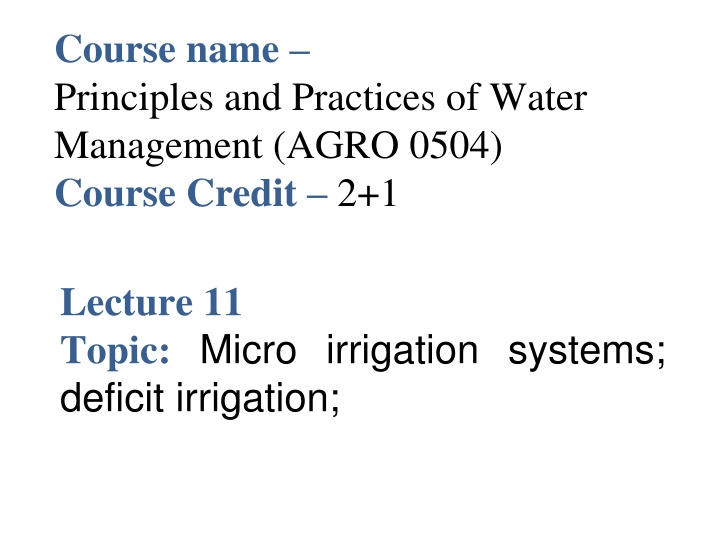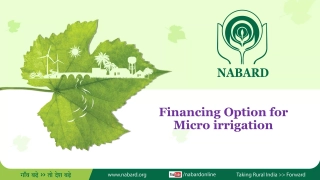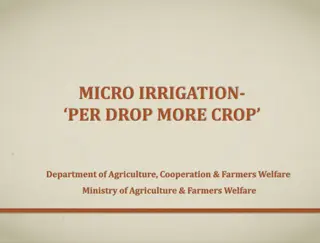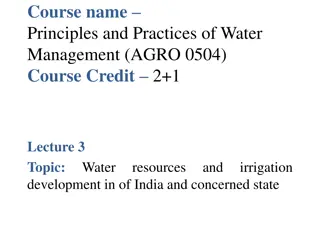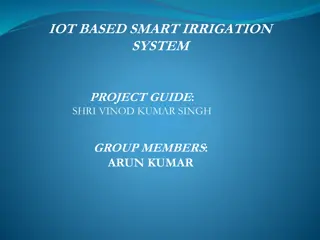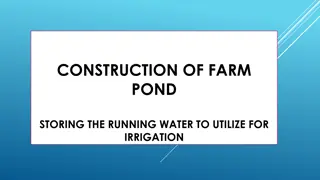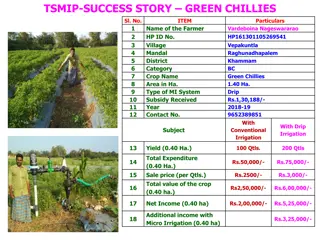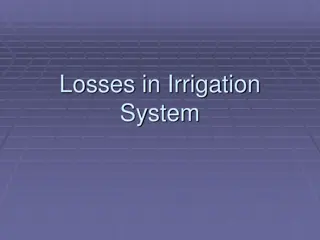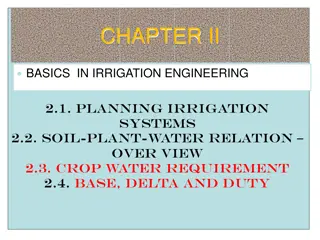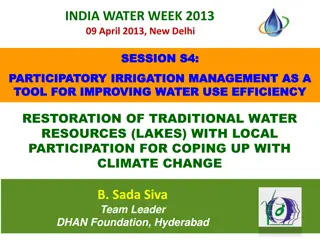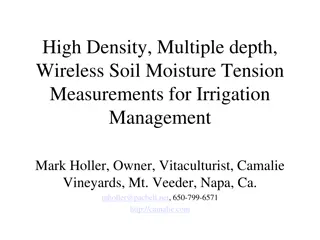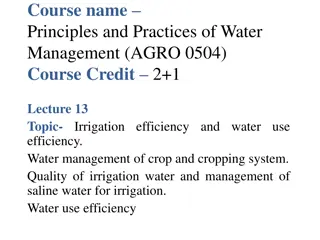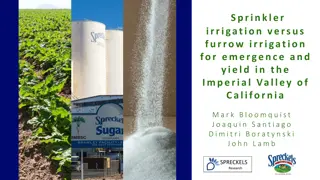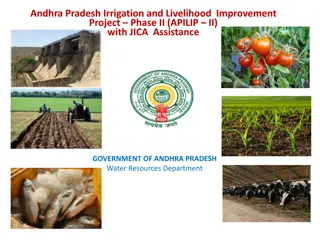Principles and Practices of Micro Irrigation Systems
Explore the world of drip irrigation, a precise and efficient method of watering crops. Originating in Israel in 1964, drip irrigation is widely adopted in regions with water scarcity and salt issues. This system enables controlled water application to a variety of crops, increasing yield and conserving resources. Discover the adaptability, efficiency, and suitable crop options for drip irrigation, along with different types of drip irrigation systems available.
Download Presentation

Please find below an Image/Link to download the presentation.
The content on the website is provided AS IS for your information and personal use only. It may not be sold, licensed, or shared on other websites without obtaining consent from the author.If you encounter any issues during the download, it is possible that the publisher has removed the file from their server.
You are allowed to download the files provided on this website for personal or commercial use, subject to the condition that they are used lawfully. All files are the property of their respective owners.
The content on the website is provided AS IS for your information and personal use only. It may not be sold, licensed, or shared on other websites without obtaining consent from the author.
E N D
Presentation Transcript
Course name Principles and Practices of Water Management (AGRO 0504) Course Credit 2+1 Lecture 11 Topic: Micro irrigation systems; deficit irrigation;
Drip (or) Trickle irrigation Drip irrigation is defined as the precise and slow application of water in the form of discrete or continuous or tiny streams or miniature sprays through mechanical devices called emitters at the specific point. In 1964, Symcha Blas , an Israeli engineer first developed the irrigation system. USA has the largest area under drip irrigation. In India, Maharashtra has the largest area under drip irrigation.
Drip irrigation Adaptability: Arid regions Areas under water scarcity and salt problems. For various types of crops like grape, apple, strawberry, corn, cotton, sugarcane, tomato, cauliflower, lettuce, cucumber, onion etc. Efficiency of drip irrigation: Ex.- Sugarcane under drip irrigation system yields about 1000 t/ha, 35% more than conventional irrigation.
Suitable crops Drip irrigation, like other irrigation methods, will not fit every agricultural crop, specific site or objective. Presently drip irrigation has the greatest potential in the following crops:
a)Fruit crops Mango, citrus, grapes, guava, pomegranate, banana, papaya, watermelon, Litchi, Fig, Ber, Amla, Sapota etc b) Vegetable crops Tomato, Brinjal, Bhendi, Cabbage, Cauliflower, Capsicum, Chillies gourds etc c) Plantation crops Oil palm, Coconut, Arecanut, Cashewnut, Coffee, Tea etc d) Field crops Cotton, Sugarcane, Tobacco, Sugarbeet, Castor etc e) Tuber & Bulb crops Potato, Cassava, Onion, Sweet potato, Radish, Colocasia etc f) Spices Turmeric, Ginger, Cardamom etc
Drip irrigation Types of drip irrigation system: Surface drip irrigation system Sub-surface drip irrigation Continuous- flow Drip irrigation Fertigation: Application of irrigation water along with fertilizer in amount and in location at a rate which matches the plant requirement is known as fertigation.
Drip irrigation Indigenous drip method of irrigation: This method is cheap, consists of mud pots of 20 liters capacity with pencil size hole made a little above the bottom. These pots are kept buried neck deep in the basins of fruit trees. The pots are filled with water and covered with lid. Water slowly trickles from the pot and replenishes the root zone. This method is suitable for young fruit trees and vegetable crops. By this method, considerable amount of water is saved.
Drip irrigation Advantages Disadvantages 1)Initial capital investment is 1)Irrigation is possible with low available discharge. 2)High water efficiency. 3)Labour requirement is low. 4)Improves fertilizer efficiency. 5)Weed growth is minimum. 6)Possibility of using saline water. high. 2)High skill is required for application design, installation and maintenance of the system. use 3)Clogging of emitters may create problem.
The application of water below the evapotranspiration requirements of the plant is called deficit irrigation.
Yield Response Factor (Ky) Y AET = a a 1 1 K y Y AET m m
Deficit irrigation is an optimization strategy Here irrigation is applied during drought-sensitive growth stages of a crop. Outside these periods, irrigation is limited or even unnecessary if rainfall provides a minimum supply of water. Water restriction is usually imposed at early vegetative and the late ripening stages. While this inevitably results in plant stress and consequently in production loss. Deficit irrigation maximizes irrigation water productivity.
Fully irrigated plants usually have widely opened stomata. Plants open their stomata for intake of CO2 but will lose significant quantities of water. A small narrowing of the stomatal opening can reduce water loss substantially with little effect on photosynthesis rate. Plants have the capability to increase their WUE in this way, thereby maximizing their chance of surviving a period of drought, potentially without a great reduction in carbon gain and biomass accumulation. By regulating their stomatal conductance, plants are able to detect the degree of soil drying and then respond to it. A feed-forward mechanism may work through a range of chemical growth regulators such as abscisic acid (ABA), 1-aminocyclopropane-1-carboxylate (ACC), and Cytokinins, which might act as signals of the degree of soil drying.
Plant physiological responses to deficit irrigation Stomata are pores on leaf surfaces through which plants exchange CO2, water vapour, and other constituents with the surrounding environment. In general, stomatal conductance depends on stomatal density and size, and more stomata will provide more pores for transpiration. Under the given conditions,water stress caused by deficit irrigation may result in stomatal closure and thus reduce transpiration rate. Many researchers have reported that stomatal density responds to various environmental factors and water deficit leads to an increase in stomatal density and a decrease in stomatal size.
Under deficit irrigation, plant hormone abscisic acid is produced in roots and shoot and acting as a signaling chemical to the leaves where it triggers stomatal closure
Crop Cotton
Water-use process regulation by changing the drying and wetting method of plant root zones
Deficit irrigation can be implemented through i) Depth of Irrigation ii) Method of Irrigation
Photographs of irrigation methods All furrow irrigation Alternate furrow irrigation Paired row irrigation
